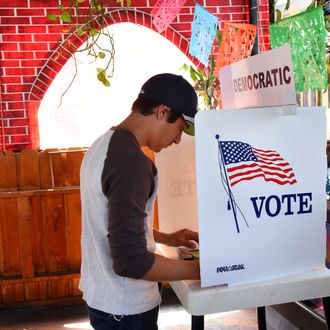
On the evening of June 7, not long after the polls closed for the California primary, Hillary Clinton was projected the winner, ending Bernie Sanders’s very-slim hopes of catching her, as the national pledged-delegate leader. Even then, we were warned that the final vote count would take a good while. Some Sanders fans even predicted he would ultimately win, based on the theory that voters who mailed in ballots at the last minute or had on-site ballots classified as “provisional” would overwhelmingly be independents feeling the Bern.
Just over a month later, California’s Secretary of State announced the counting of ballots from the primary had come to an end. Nearly 1.7 million votes were added to the election-night totals for the Democratic presidential contest, and Bernie Sanders did indeed win a majority of the new votes — though only enough to shave Clinton’s popular-vote margin from 12 to 7 percent, and her delegate majority in the state from 63 to 33.
What took so long? There were basically two factors. For the first time this year, California allowed the counting of mail ballots postmarked by election day and received within the next three days (previously, they had to be received before the polls closed). This is the same permissive system used by another heavy vote-by-mail state, Washington, where vote-counting often seems to take forever.
There was also a lot of confusion about balloting rules for voters registered as independent (or “No Party Preference”) voters. In everything other than the presidential contest, party registration no longer really matters in California; under the top-two system, everyone gets the same ballot, and the top two finishers, regardless of party affiliation, proceed to the general election. But for the presidential primary, voters only got to choose from the candidates in their own primary, and indies voting by mail received a blank ballot unless they asked for a Democratic ballot (Republicans chose not to let indies vote in their primary). This led to a lot of late voting by No Party Preference people, and also an unusually high number of provisional ballots with apparent but potentially curable mistakes. All this took time to sort out, but the idea that the rules were somehow contrived to help Clinton or hurt Sanders is entirely imaginary. If anything, the “postmark” allowance probably helped Sanders, and the conflict in rules for the presidential and non-presidential systems is a product of a 2010 ballot initiative complicated by litigation.
What really happened in California was part of a continued blurring of the concept of “election day” in places with heavy voting-by-mail and inevitably large provisional ballots caused by complex primary rules. It’s another argument for more national standards for voting, but it will probably take a real national voting scandal to produce such a change. And as Florida 2000 showed, even that may not overcome the American bias for localized, crazy-quilt voting procedures.






























